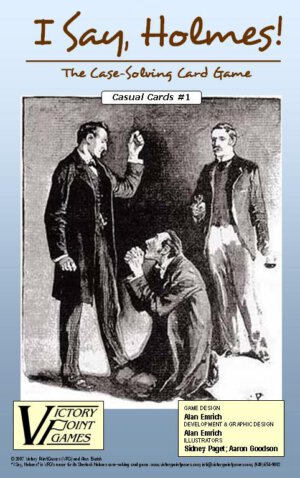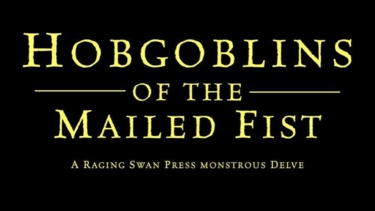
Publisher: Victory Point Games
Designers: Alan Emrich and Roger Heyworth
Year: 2007
Players: Three to eight players
Ages: 8+
Playing Time: 25 Minutes
Retail Price: $20.95
I’ve always had a soft spot for Sherlock Holmes. In fact that entire period of history. Basically, late 1800’s and early 1900’s London, with Holmes, Dracula, Jack the Ripper, Jules Verne, among many others both real and imagined are all fascinating and exciting. So, I enjoy a good Sherlock Holmes game needless to say.
I Say, Holmes is Victory Point Games card based Sherlock Holmes game. The game has 120 cards and rules. It comes in a ziplock bag as do most of their games.
Lets take care of the good first. I liked it. It was fun and interesting and had some cool twists. The cards feature the original artwork of Sydney Paget, from the illustrations that accompanied the Sherlock Holmes stories as they first appeared over 100 years ago. There is also a location chit, with London on one side and the country on the other. Some of the cards have small numbers on them that indicate how many players they are used with. For example, with 5 players you look for all the cards with the number 5 or less. The numbered cards are shuffled and passed out to the players, giving them each six cards. The remaining, unnumbered cards are the draw pile. 
One of the players was dealt a card called “The Game Is Afoot”. This player goes first and plays the card. The next player to the right then gets to play a card. Along the bottoms of each card are colored boxes that indicate which cards can be played on top of it. So with “The Game is Afoot” card, the next player must play a blue movement card. There are several different types of cards, and players can move from London locations out to the county, and back, which is indicated by flipping the location chit over. Clue cards allow you to look at other players cards, Inspector cards force another player to draw two cards. Alibi cards can be used to cancel one of these penalties, and so on. If the player has no legal card that can be played, they must draw a card, then play passes to the next player.
The cards each also have point values, and the object of the game is to have the lowest number of points when the game is over. The highest value cards are the villain cards. When a player plays an “Arrest” card, they must accuse one of the other players of harboring the villain. If the player they name is holding a villain card, the hand is over. That player is guilty. All of the players add up the point totals of their cards. The Arresting player gets to subtract the villain’s point value from their score, and the guilty player adds the total.
If on the other hand, the Arresting player guesses wrong, they have to add all of that players cards to their own. The not guilty player draws a new set of cards and play continues.
If a player runs out of cards before an arrest is made, the hand is over and players start arresting and accusing each other until the villain is found. If a player finds themselves with only villain cards in their hand, the villains 
There are lots of little twists and special cards. It makes for some great game play. You play for a pre-determined number of hands, and when you are all done the player with the lowest score wins the game.
Now for the bad stuff. The cards are of the same manufacture as all of the VPG games are, basic small cards, uncoated, and difficult to deal and shuffle. In most of their games it is not a big deal, because you only shuffle once or twice and that’s it. In this game, you are shuffling a lot. There is one card that forces you to shuffle the discard and draw pile together, so you end up shuffling the numbered and non-numbered cards together. When the hand is over you have to sort through all of the cards again to separate them, and it is a real pain in the butt.
One game play issue is that whenever someone plays a movement card that says “Thick Fog”, all of the players must throw their hand of cards into a pile, then these are shuffled, and the same number of cards are returned to each player. Basically, this moves all the cards around, and the villain can move from one player to another, which is actually neat. However, this happens constantly early on, often multiple times in a row, as there are a lot of cards that say “Thick Fog”. It gets to be really annoying, especially since the cards are so hard to shuffle and deal out. I’d like to see a lot less “Thick Fog”.
That’s all the problem I had with the game, not a deal breaker by any means for me, but it will be for many players. The game is inexpensive enough that the non-glossy cards are no big thing. I might look into getting card sleeves, or getting them laminated. Already I have fond memories of a hand that I got to pass my villain card to my son (He’s 17, he can handle it) and then was able to play an arrest card immediately afterwards on him, winning the hand for myself. It was victory from defeat, very satisfying. A good game.
The game is a reworking of Sherlock Holmes: The Card Game, published in 1991 from Gibson Games for those who love the original, which has been out of print for a long time.
- A Dungeon Delve for Kids?: A Review of Dungeon! - Oct 24, 2022
- Better, Stronger, Faster | Descent: Journeys in the Dark Second Edition Reviewed - Oct 23, 2022
- Your Planet is Doomed!: Invasion from Outer Space Reviewed - Oct 22, 2022














1 Comment
Yes, the Victory Point Games cards are difficult to shuffle. One thing that I have found makes it easier is to round the corners of the cards using one of the corner cutters that one can get at office supply stores.